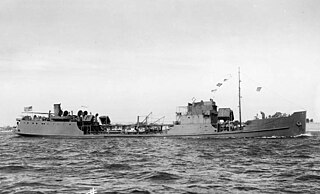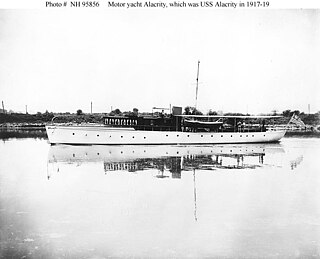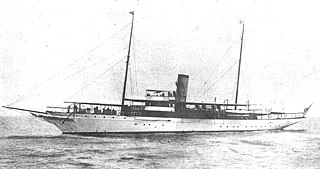
USS Cyrene (AGP-13) was a motor torpedo boat tender for the United States Navy. She was laid down as Cape Farewell, a Maritime Commission type (C1-A) hull under a Maritime Commission contract, at Pusey and Jones Corp., Wilmington, Delaware. Cyrene served in the Pacific from New Guinea to the Philippines from December 1944 to December 1945. The ship was decommissioned and placed in the Suisun Bay Reserve Fleet in July 1946 then withdrawn from the reserve fleet after sale to American Ship Dismantlers in December 1976.

USS Monadnock (ACM-10) was a coastal minelayer in the U.S. Navy, the third vessel named after Mount Monadnock, a solitary mountain (monadnock) of more than 3,100 feet in southern New Hampshire close to the border of Massachusetts. The ship was built as the cargo vessel Cavalier for the Philadelphia and Norfolk Steamship Company by Pusey and Jones Corporation, Wilmington, Delaware in 1938. The Navy purchased the ship 9 June 1941 for wartime use. After decommissioning the ship was sold in June 1947 for commercial use then sold to a Panamanian company in 1949 to be renamed Karukara. In 1952 the ship became Monte de la Esperanza for a company in Bilbao, Spain transporting bananas to the United Kingdom from the Canary Islands for more than 20 years. She was later sold to the Marine Institute of Spain for operation as a hospital ship for more than 10 years serving the fishing fleet of the Canary Islands as Esperanza del Mar until becoming an artificial reef off Spain in 2000.

USS Miantonomah (CM-10/CMc-5) was built as SS Quaker by Pusey & Jones Corporation, Wilmington, Delaware in 1938 as a commercial coastwise ship operating as a fast inland water passenger and freight carrier. Quaker was acquired by the Navy in May 1941 for conversion to a coastal minelayer. Miantonomah operated off the east coast of the United States, Africa and the Mediterranean and took part in the invasion of Europe in 1944. The ship was sunk by a mine 25 September 1944.

USS Guyandot (AOG-16) was a gasoline tanker acquired by the U.S. Navy as Veedol No. 2 from Tidewater Oil to serve as a gasoline tanker. The tanker served in Mediterranean operations often under air attack. After postwar decommissioning January 1945 in Algeria and service with the French under lend-lease the tanker was purchased in March 1949 by France serving under the name Lac Noir.

United States lightship Nantucket (LV-112) is a National Historic Landmark lightship that served at the Lightship Nantucket position. She was the last serving lightship and at time of its application as a landmark, one of only two capable of moving under their own power. She served as the lightship for such notable vessels as the liners United States, Queen Mary, and Normandie.

USS Alacrity (SP-206) was a steel cruising yacht that served in the US Navy as a section patrol craft. It was built by Pusey & Jones at Wilmington, Delaware for W. A. Bradford in 1910 then sold to John H. Blodgett of Boston.

USS Hunting (E-AG-398) was built as the LSM-1-class landing ship medium LSM-398 at the Charleston Navy Yard and launched in the first week of 1945. After service in the Atlantic as a landing ship the vessel was converted in 1953 to a sonar research vessel for the Naval Research Laboratory. Hunting was unique among Navy research vessels of the time in having a center well through which large towed "fish" could be transported and lowered to operating depths. The work contributed to sonar improvements and understanding ocean acoustics.

USS Crystal (PY-25), built in 1929 as the yacht Cambriona for Walter O. Briggs of Detroit, Michigan, was a patrol yacht in the United States Navy. The Navy acquired the yacht in January 1942 as Vida commissioning the vessel as Crystal in February. Naval service was in Hawaii until November 1945. After sale in November 1947 the vessel operated commercially in Central and South America.

USS Nokomis (SP-609) was a yacht purchased by the U.S. Navy during World War I. The yacht was purchased from Horace E. Dodge of Detroit, Michigan after he had the yacht luxuriously fitted out but before he could make use of his second Nokomis — the first having already gone into service.

USS Lydonia (SP-700) was United States Navy patrol vessel in commission from 1917 to 1919 that saw service during World War I. Prior to her U.S. Navy service, she had been William A. Lydon's private yacht, Lydonia II, from 1912 to 1917. She spent most of the war based at Gibraltar, escorting and protecting Allied ships in the Mediterranean and along the Atlantic Ocean coast of Europe. After her U.S. Navy service ended, she served from 1919 to 1947 in the United States Coast and Geodetic Survey as the coastal survey ship USCGS Lydonia (CS-302).

USS Artemis (SP-593), launched as the steam yacht Cristina then upon sale the yacht was renamed Artemis. The yacht was purchased by the United States Navy during World War I and the name was retained. Artemis was armed with guns and depth charges and sent to Europe as a patrol craft to protect Allied ships from German submarines and other dangers. The patrol yacht was renamed Arcturus in 1918. Post-war she was returned to the United States and turned over to the United States Coast and Geodetic Survey. Later, again Artemis, the vessel was in civilian operation until burning and sinking in 1927.
The Pusey and Jones Corporation was a major shipbuilder and industrial-equipment manufacturer. Based in Wilmington, Delaware, it operated from 1848 to 1959.

USS Zircon (PY-16) was the private yacht Nakhoda acquired by the United States Navy in 1940 serving as an armed yacht from 1941 to 1946. The yacht Nakhoda was built for automobile executive Frederick J. Fisher by Pusey and Jones Corporation, Wilmington, Delaware delivered in 1930. After the war the yacht was sold and reverted to the original name until sold in 1951 to the United New York Sandy Hook Pilots Association and renamed New York.

Rosinco was a diesel-powered luxury yacht that sank in Lake Michigan off the coast of Kenosha, Wisconsin in 1928. The yacht was built in 1916 as Georgiana III and served during World War I as USS Georgiana III, a Section patrol craft, under a free lease to the Navy by her owner and commanding officer. After the war the yacht was sold and renamed Whitemarsh in 1918. In 1925, after sale to Robert Hosmer Morse of Fairbanks-Morse, the yacht became Rosinco. She was sunk following a collision in 1928 and the wreck was added to the National Register of Historic Places in 2001.

USS Phenakite (PYc-25) was a converted yacht that was used by the United States Navy during World War I and World War II. The vessel was also known as Celt, Sachem (SP-192), Sightseer and Circle Line V.
Velero III was a motor vessel built for George Allan Hancock at Craig Shipbuilding, Long Beach, California, with the intention of using the vessel for both business and research. Hancock was a donor to the University of Southern California with Velero III eventually becoming R/V Velero III in research associated with the university and a sculpture of the vessel appears on the Hancock Institute for Marine Studies at U.S.C. The ship was purchased for war use by the Navy on December 15, 1941 and being commissioned as the USS Chalcedony designated PYC-16 on weather duty for the Hawaiian Sea Frontier.

USS Siren (PY-13), briefly CMc-1, was built by Pusey and Jones, Wilmington, Delaware and launched 15 November 1929 as the yacht Lotosland. The yacht was acquired by the United States Navy in October 1940 and placed in commission as a Patrol Yacht from 1940 to 1946.
HMCS Vison was an armed yacht of the Royal Canadian Navy during World War II. The vessel was acquired in 1940 for use as a patrol boat and later, as a training ship. In 1946, following the end of the war, Vison was sold into private ownership. The vessel was constructed as Avalon in 1931 by Pusey & Jones of Wilmington, Delaware, United States on behalf of Ogden L. Mills, the Secretary of the United States Treasury. During its service during World War II, Vison participated in the Battle of the Atlantic and the Battle of the St. Lawrence escorting convoys and defending them against German U-boats.
SS John Cadwalader was a coastal passenger and cargo steamer launched in March 1926 by Pusey & Jones Corporation, Wilmington, Delaware for the Baltimore-Philadelphia Steamship Company for operation on overnight service between Baltimore and Philadelphia. The intended route used the Chesapeake and Delaware Canal for an inland passage using Chesapeake Bay, Delaware Bay and the Delaware River.
Gen. E. O. C. Ord was a United States Army Coast Artillery Corps mine planter built in 1909 by Pusey & Jones of Wilmington, Delaware to an Army Quartermaster Corps design. The mine planter was among the first vessels specifically designed to plant controlled mines in association with coastal fortifications. The first group had been built in 1904 with a second group built in 1909. Four of the 1909 planters, the first to be specifically designed for mine planting, were 165 ft (50.3 m), steam-powered, twin-screw vessels. At the time the vessels were civilian crewed. In 1918 the Army Mine Planter Service of uniformed Army personnel was formed to operate the vessels.

















